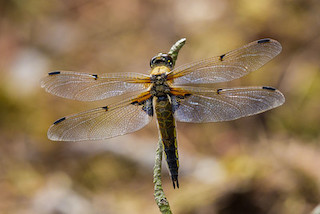 A common sight in the summer, watch out for the darting, hovering flight of the Four-spotted Chaser dragonfly.
A common sight in the summer, watch out for the darting, hovering flight of the Four-spotted Chaser dragonfly.
Photo: © Natural England/Allan Drewitt
Scientific name: Libellula quadrimaculata
Other common names: Four-spotted Skimmer (in North America)
Conservation status: IUCN Red List: Least Concern
What to look for:
- Colouring: Brown abdomen with a dark tip, with yellow spots along the side in both sexes
- Size: Up to 4.5 cm in length, with a wingspan of up to 8 cm
- Where: This common dragonfly species can be found across Britain. It breeds in waterbodies, mostly in standing water, but can be seen far from water as it migrates in search of new suitable breeding territory
- Similar species: It could be confused with Broad-bodied Chaser females (male Broad-bodied Chasers have a pale blue abdomen), but the dark spot halfway along the edge of each of the wings is diagnostic
 At this time of year, a walk by a pool or river on a warm day will be an unusual one if you don’t spot any dragonflies. One of the more common species, but no less impressive for that, is the Four-spotted Chaser, which you can see on the wing between May and August. Widespread across Britain, this dragonfly has a range that extends across Europe, North America and northern parts of Asia. Both sexes look similar, with yellow spots along each side of the honey-brown abdomen. Their most recognisable feature is the presence of a dark spot halfway along each of its four wings – hence its common name.
At this time of year, a walk by a pool or river on a warm day will be an unusual one if you don’t spot any dragonflies. One of the more common species, but no less impressive for that, is the Four-spotted Chaser, which you can see on the wing between May and August. Widespread across Britain, this dragonfly has a range that extends across Europe, North America and northern parts of Asia. Both sexes look similar, with yellow spots along each side of the honey-brown abdomen. Their most recognisable feature is the presence of a dark spot halfway along each of its four wings – hence its common name.
The males defend their territory aggressively against intruders, and can be spotted patrolling up and down as they hunt for food, or perching amongst the vegetation, often favouring the same spot. Males and females mate in flight during the summer, after which the female, guarded by the male, drops her fertilised eggs into the water as she hovers, flicking her abdomen into the water. The larvae, like all dragonfly nymphs, are active predators, ambushing prey from amongst the mud and plants at the bottom of the waterbody for about two years, before climbing up vegetation to complete their emergence as a fully-winged adult.
Did you know…?
…Dragonflies do not go through a pupal stage in their development, unlike butterflies. The adult emerges from the final moult of the larval stage, which takes place above the waterbody surface.
…If themselves threatened by a predator, the larvae will sometimes pretend to be dead to avoid capture.
More information and references:
Chinery, M., 2004. Collins Complete Guide to British Insects. Collins, London.
Published: June 2014
Author: Amanda Scott
Photos: © Natural England/Allan Drewitt

